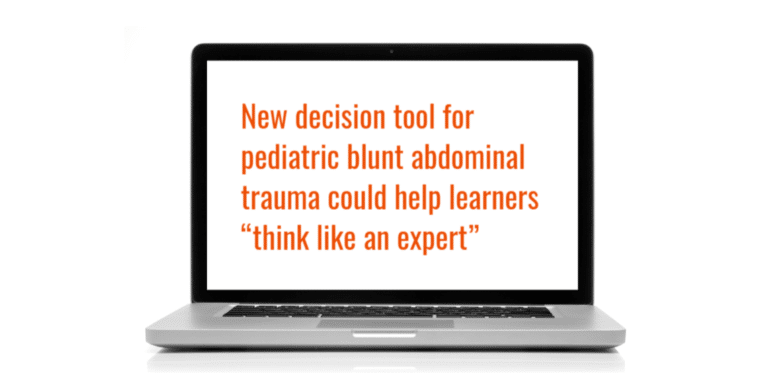Blunt abdominal injury is the third most common cause of trauma mortality in children. It is also the most common unrecognized fatal injury in the pediatric population.
To manage these patients effectively, physicians must be very familiar with children’s response to abdominal trauma, recognize important sensory cues and avoid common pitfalls. Yet most injured children are cared for by providers who do not have extensive experience in pediatric trauma.
To address this gap, researchers at Children’s Mercy Hospital in Kansas City, Missouri, used cognitive task analysis (CTA) to identify the thought processes that pediatric trauma experts use when managing children with blunt abdominal trauma.
“Decision-making for management of traumatic patients is second-nature for experts,” the Children’s Mercy team noted, “but it may be challenging for them to provide a detailed account of their thought process.”
By using CTA to study how experts think, the researchers have created tools that could help trainees — and other physicians with limited experience of pediatric blunt abdominal trauma — quickly improve the care they provide to these patients.
The team recently described their work in a peer-reviewed report published in The Cureus Journal of Medical Science.
Using CTA to identify expert thought processes
Cognitive task analysis is a method for breaking down a complex task into critical steps, thought processes and decision points. “In other words, CTA is a way to understand how an expert thinks by identifying cognitive activities needed to complete a task,” the Children’s Mercy group noted. Insights drawn from CTA can be used to develop training materials and procedural checklists.
In this study, the research team conducted semi-structured interviews with a focus group of pediatric trauma experts. The interviews centered on two clinical vignettes designed to draw out the experts’ approach to decision making for pediatric blunt abdominal trauma.
The researchers analyzed the interview transcripts for important themes, issues and steps. To validate their results, they invited a nationwide sample of experts in pediatric emergency medicine and trauma to review their findings via a survey.
Comprehensive trauma decision tool
The main product of the group’s CTA is a Comprehensive Decision-Making Tool for Evaluation of Pediatric Blunt Abdominal Trauma.
The tool breaks the process down into four phases: EMS to arrival at the hospital, first 5 minutes of care, first 15 minutes, and first 60 minutes. Each phase is divided into discrete management steps. For each step, the tool describes assessment priorities, key decisions, pitfalls to avoid and common opportunities for improvement.
For example, during the central circulation assessment, experts agreed that one of the key decision points is whether there is evidence of shock. According to the study, pediatric trauma experts pay particular attention to tachycardia:
“Tachycardia is the earliest sign of shock / Children can have significant blood loss (up to 40%) and be capable of compensation, so their blood pressure may be in the normal range / There are many causes of tachycardia other than shock, but it must be explained in the trauma setting (potential causes include acute blood loss, hypoxemia, pain, fear, anxiety or a combination).”
Potential errors and novice traps in pediatric trauma management
The researchers also identified several specific errors that inexperienced practitioners may fall into when managing patients with pediatric blunt abdominal trauma. According to the expert subjects, top errors and novice traps include:
Tunnel vision — The tendency to fixate on obvious problems is a common source of error in pediatric trauma management. “With novices it’s hard to ignore the obvious,” one expert in the study stated. “If blood and guts are hanging out, they focus on that.”
Delayed recognition — Failure to recognize abnormal vital signs is a potential error in pediatric trauma management. In addition, experts noted that delayed recognition of shock is a consistent problem.
Non-systematic examination — Experts in the study identified incomplete physical examination as a common problem. One expert stated, “90% of where people will mess up, is … going out of order, not being systematic … when the person doing the evaluation goes off of that [head to toe]standard, things get lost, they don’t know where they left off, they don’t know what they’ve examined, they don’t know if they have looked at the chest or the back or they get confused. And once the leader gets confused, then everyone’s confused.”
Failure to prioritize tasks — The study showed that experienced practitioners are adept at ordering tasks in terms of priority. An expert in the study put it this way: “What’s going to kill the patient and what’s going to save the patient? A shoulder injury is not going to kill the patient.”
Other potential novice traps include missing sensory cues, omission bias (e.g., when failure to logroll a patient leads to missed injuries), failure to coordinate team activities, lack of identified team leader, poor crowd control, over-testing, failure to revise and failure to summarize.

